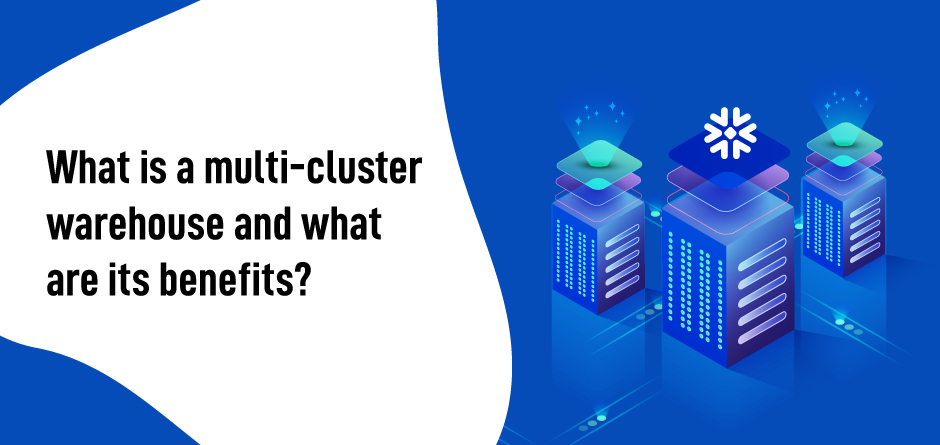
What is a Multi-cluster Warehouse and What are its Benefits
The business landscape has witnessed a rapid transformation in recent years due to cloud technology. The hassles of storing and managing sensitive business data are no longer applicable due to the benefits and agility of the cloud. As businesses grow in operations, the data generated increases.
It has led to the discovery of data warehousing that stores operational data and other critical information or organizations. Data warehouses also store historical information that businesses can use for analysis and improve their decision-making. A multi-cluster warehouse offers advanced benefits. Let’s understand them in this article.
What is a warehouse?
A virtual warehouse, also referred to as a warehouse, is a cluster of computing resources in Snowflake. A warehouse offers the essential resources, like CPU, memory, and temporary storage, to accomplish the operations during a Data Warehouse. Warehouses are critical for queries and DML operations, including loading data into tables.
A warehouse gets defined by its size, additionally because the other belongings can be set to assist control and systematize warehouse activity. You can start and stop warehouses at any time. They can even get resized consecutively to accommodate the necessity for computing resources. It gets supported by the type of operations of the warehouse.
How can you size a warehouse?
Snowflake Warehouse is available in various T-Shirt sizes
An increase in T-Shirt size(XS – 4XL) depicts a rise in CPU, Memory, Temporary Storage as per pre-defined proportion. You do not have any control over the dimension individually, but you can change warehouse size by choosing one of the T-Shirt sizes. You’ll be able to start & stop the warehouse anytime as Snowflake storage and compute remain loosely coupled.
At the creation time, you’ll have to provide the scale, multi-cluster attribute (enterprise & above) & scaling policy.
What is a multi-cluster warehouse?
Multi-cluster warehouses enable you to scale compute resources to manage your user and query concurrency needs as they alter, like during peak and off-hours.
By default, the dimensions of a virtual warehouse determine the compute resources available to the warehouse for executing queries. Each warehouse could be a set of computing resources. As queries get submitted to a warehouse, the warehouse allocates resources to every query and begins executing them.
If sufficient resources don’t remain available to execute all the queries submitted to the warehouse, Snowflake queues the additional queries until the mandatory resources become available. With multi-cluster warehouses, Snowflake supports allocating, either statically or dynamically, more warehouses to form a bigger pool of computing resources available. You can define a multi-cluster warehouse by specifying the following properties:
- A maximum number of warehouses, greater than 1 (up to 10).
- A minimum number of warehouses up to or but the most (up to 10).
Additionally, multi-cluster warehouses support all the identical properties and actions as single warehouses, including:
- Specifying a warehouse size.
- Resizing a warehouse at any time.
- Auto-suspending a running warehouse due to inactivity; note that this doesn’t apply to individual warehouses but the entire multi-cluster warehouse.
- Auto-resuming a suspended warehouse when new queries are submitted.
Benefits of Multi-Cluster Warehouse
Through a standard, single-cluster warehouse, if your operator/query load rises to the point where you need more compute resources:
- You must either raise the entire size of the warehouse or start extra warehouses and redirect the additional operators/queries to these warehouses.
- Then, when the resources are no longer needed, to conserve credits, you must manually rationalize the larger warehouse or append the additional warehouses.
In contrast, a multi-cluster warehouse allows larger numbers of users to connect to the same size warehouse. In addition:
- In Auto-scale mode, a multi-cluster warehouse eliminates the need for resizing the warehouse or initial and ending additional warehouses to handle fluctuating workloads. Snowflake automatically starts and stops added warehouses as needed.
- In Maximized mode, you can control the volume of the multi-cluster warehouse by increasing or decreasing the number of warehouses as needed.
Bottom line
The multi-cluster warehouses offered by Snowflake are popular among various businesses as they offer a range of benefits. You can leverage it to experience increased agility and seamlessness with your data. It will ultimately help you improve your decision-making capabilities by making the best use of historical data.
If you are looking for expert support for Snowflake multi-cluster warehouse operations, Omnepresent can help. Contact us today to know more details about our services.
RECENT POSTS
CATEGORIES
